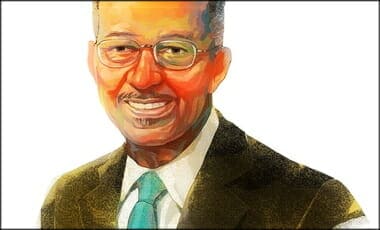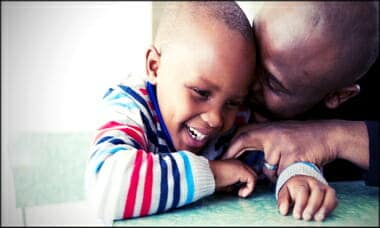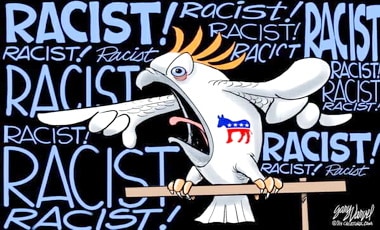- Among the many wise things said by the late Senator Daniel Patrick Moynihan was that you are entitled to your own opinion, but not to your own facts. — Thomas Sowell
Armstrong & Getty read from honest lefty New York Times contributor regarding the state of the [esp.] black family. The article’s author is Nicholas Kristof, and the title is “The One Privilege Liberals Ignore” (link to the article – reproduced below in appendix). Milton Friedman and Thomas Sowell, as well as Larry Elder and Walter Williams have been talking about this for many decades. So Kristof is standing on the vapors of giants.
THOMAS SOWELL: His 1982 book Race and Economics mentions Moynihan’s report, and in 1998 he asserted that the report “may have been the last honest government report on race.” In 2015 Sowell argued that time had proved correct Moynihan’s core idea that African-American poverty was less a result of racism and more a result of single-parent families: “One key fact that keeps getting ignored is that the poverty rate among black married couples has been in single digits every year since 1994.”
SOME OF MY VIDEO UPLOADS:
- Larry Elder Quotes Obama on Fatherless Homes (YOUTUBE | Uploaded November 26, 2014)
- Fatherless Homes and Poverty – Europe and America: Larry Elder and Thomas Sowell (YOUTUBE | Uploaded September 21, 2016)
- Fatherless (Black) Homes in Milwaukee – 85% (YOUTUBE | Uploaded June 26, 2017) – the percentages is more now. Sadly.
- Fatherless Homes The Problem – Denzel Washington (YOUTUBE | Uploaded April 4, 2018)
- Boys Need Fathers – Warren Farrell (YOUTUBE | Uploaded March 4, 2019)
Fatherless Homes The Problem – Denzel Washington
(Uploaded April 4, 2018)
SOME ARTICLES:
- Fatherless Households: A National Crisis (Larry Elder, CREATORS | October 2020)
- To Truly Reduce Racial Disparities, We Must Acknowledge Black Fathers Matter (FEDERALIST | June 2020)
- The Black Family: 40 Years of Lies: Rejecting the Moynihan report caused untold, needless misery (CITY JOURNAL | Summer 2005)
- How Much Does Politics Count? (Walter Willaims, CREATORS SYNDICATE | November 2006)
- Random thoughts (Thomas Sowell, WAYBACKMACHINE | April 1999)
The below is taken from Walter Williams “Race and Economics: How Much Can Be Blamed on Discrimination?”
[The source I got this from mislabeled/lost a few footnotes. So, a couple numbered referenced footnotes notes may be placed a sentence or two too early or late. I could correct it, however, I am not digging through thousands of books to find my copy.]
While material poverty in its historical or global form is nonexistent in the U.S., what I call behavioral poverty has skyrocketed. Female-headed households increased from 18 percent of the black population in 1950 to well over 68 percent by 2000.[5] As of 2002, 53 percent of black children lived in single-parent households, compared to 20 percent for whites.[6] As of 2006, roughly 45 percent of blacks fifteen or older had never been married, in addition to 17 percent who had been divorced or widowed; that contrasts with only 27 percent of whites fifteen and older never married and 16 percent divorced or widowed.[7]
Some argue that today’s weak black-family structure is a “legacy” of slavery. Such an explanation loses credibility when one examines evidence from the past. Even during slavery, where marriage was forbidden, most black
children lived in biological two-parent families. One study of nineteenth-century slave families found that in as many as three-fourths of them, all the children had the same mother and father.[8] In New York City, in 1925, 85 percent of kin-related black households were two-parent households.[9] In fact, “Five in six children under the age of six lived with both parents.” [10]
A study of 1880 family structure in Philadelphia shows that threequarters of all black families were nuclear (composed of two parents and children). What is significant, given today’s arguments that slavery and discrimination decimated the black family, is the fact that years ago there were only slight differences in family structure between racial groups. The percentages of nuclear families were: black (75.2 percent), Irish (82.2), German (84.5), and native white American (73.1).[11] Only one-quarter of black families were headed by females. Female-headed families among Irish, German, and native white Americans averaged 11 percent.
Also significant was the fact that, in 1847, just one of ten Philadelphia blacks had been born in slavery. However, those ex-slave families were more likely than free-born blacks to be two-parent families.[12] Theodore Hershberg found that 90 percent of households in which the head purchased his freedom included two parents. He found that those households existed 80 percent of time among ex-slaves in general and 77 percent of the time among free-born blacks.[13] Historian Herbert Gutman found, in analyzing data on families in Harlem between 1905 and 1925, that only 3 percent of all families “were headed by a woman under thirty.”[14]
Thomas Sowell reported that, “Going back a hundred years, when blacks were just one generation out of slavery, we find that census data of that era showed that a slightly higher percentage of black adults had married than white adults. This fact remained true in every census from 1890 to 1940.”[15]
Coupled with a dramatic breakdown in the black-family structure has been an astonishing growth in the rate of illegitimacy. The black rate was only 19 percent in 1940, but skyrocketed in the late 1960s, reaching 49 percent in 1975.[16] As of 2000, black illegitimacy stood at 68 percent and in some cities over 80 percent.[17] High illegitimacy rates not only spell poverty and dependency but also contribute to the social pathology seen in many black communities: high incidences of adolescent violence and predatory sex, and as sociologist Charles Murray has noted, a community not unlike that portrayed in Lord of the Flies.[18]
Several studies point to welfare programs as a major contributor to several aspects of behavioral poverty. One of these early studies was the Seattle/Denver Income Maintenance Experiment, also known as the “SIME/DIME” study. Among its findings: for each dollar increase in welfare payment, low-income persons reduced labor earning by eighty cents.[19] Using 1979 National Longitudinal Survey of Youth data, Ann Hill and June O’Neill found that a 50 percent increase in the monthly value of welfare benefits led to a 43 percent increase in the number of out of wedlock births.[20]
FOOTNOTES
- cdc.gov/nchs/data/statab/t001x17.pdf. See also Thomas Sowell, Ethnic America (New York: Basic Books, 1981), 222; and June O’Neill, “The Changing Status of Black Americans;’ The American Enterprise, vol. 3, no. 5 (September/ October 1992): 72.
- Census Bureau, “Marital Status and Living Arrangements,” Current Population Survey (Washington, D.C.: Government Printing Office, March 1998 Update), Series P-1, 20-514.
- Census Bureau, Current Population Reports, Series P-20, no. 468 (Washington, D.C.: Government Printing Office, 1992), vi, cited in Thomas Sowell, The Vision of the Anointed (New York: Basic Books, 1995), 80.
- Herbert Gutman, The Black Family in Slavery and Freedom: 1750-1925 (New York: Pantheon Books, 1976), 10.
- The Black Family, ix.
- , xix.
- Frank F. Furstenberg Jr., Theodore Hershberg, and John Modell, “The Origins of the Female-Headed Black Family: The Impact of the Urban Experience,” Journal of Interdisciplinary History VI:2 (1975): 211-233. Originally published in Kenneth L. Kusmer, ed., From Reconstruction to the Great Migration, 1877-1917, vol. 4, part II, (NewYork: Garland Publishing, 1991), 72-96.
- “The Origins,” 180.
- Theodore Hershberg, “Free Blacks in Antebellum Philadelphia: A Study of Ex-Slaves, Freeborn, and Socioeconomic Decline,” Journal of Social History 5:2 (1971-72): 194.
- Gutman, The Black Family, 449-56.
- Sowell, The Vision, 81. Prior to 1890, this question was not included in the census.
- Rector, “Why Expanding Welfare Will Not Help the Poor,” (lecture no. 450, The Heritage Foundation, Washington, D.C., 1993), 6.
- National Center for Health Statistics, National Vital Statistics Report, vol. 50, no. 5 (Hyattsville, Md.: 2002), 49.
- Charles Murray, “The Coming White Underclass,” The Wall Street Journal, October 29,1993.
- Gregory B. Christensen and Walter E. Williams, “Welfare Family Cohesiveness and Out of Wedlock Birth,” The American Family and the State, ed. Joseph Peden and Fred Glahe (San Francisco: Pacific Institute for Public Policy Research, 1986), 398.
- Anne Hill and June O’Neill, “Underclass Behavior in the United States: Measurement and Analysis of Determinants,” cited in Rector, “Why Expanding Welfare,” 6.
Here are some similar — more recent stats:
Fatherlessness is the root issue beneath so many ills that plague society today. Statistically speaking, a child who grows up without a father in the home is more likely to experience homelessness, commit crime, serve time in prison, abuse drugs, drop out of school, be obese, suffer from poverty, and so much more. And the United States has the highest share of single parenting in the world. How did we get here, and is there anything that can be done to reverse this trend? PragerU personality Amala Ekpunobi breaks it down.
A police officer and a protestor teach two young men that there is a better way than rioting. Black America needs fathers and good role models. Broken homes lead to broken communities. Larry Elder takes over from there:
APPENDIX | NYT’s Article
The One Privilege Liberals Ignore
Sept. 13, 2023 | Nicholas Kristof
American liberals have led the campaign to reduce child poverty since Franklin Roosevelt, and it’s a proud legacy. But we have long had a blind spot.
We are often reluctant to acknowledge one of the significant drivers of child poverty — the widespread breakdown of family — for fear that to do so would be patronizing or racist. It’s an issue largely for working-class whites, Blacks and Hispanics, albeit most prevalent among African Americans. But just as you can’t have a serious conversation about poverty without discussing race, you also can’t engage unless you consider single-parent households. After all:
- Families headed by single mothers are five times as likely to live in poverty as married-couple families.
- Children in single-mother homes are less likely to graduate from high school or earn a college degree. They are more likely to become single parents themselves, perpetuating the cycle.
- Almost 30 percent of American children now live with a single parent or with no parent at all. One reason for the sensitivities is large racial disparities: Single parenting is less common in white and Asian households, but only 38 percent of Black children live with married parents.
“The data present some uncomfortable realities,” writes Melissa S. Kearney, an economist at the University of Maryland, in an important book on this topic to be published next week. “Two-parent families are beneficial for children,” she adds. “Places that have more two-parent families have higher rates of upward mobility. Not talking about these facts is counterproductive.”
We liberals often perceive the world through prisms of privilege, but we rarely discuss one of the most important privileges of all — and it’s the title of Kearney’s book, “The Two-Parent Privilege.”
Let me interrupt this column with a shower of caveats. Many children raised in part by single moms do extraordinarily well; one was a two-term president in the 1990s and another served two terms until 2017. And I think the big driver for the rise in single-parent households is bad decisions by policymakers that led to mass incarceration and a collapse of earnings for working-class men.
Yet this is still so wrenching to discuss.
That goes back to 1965, when Daniel Patrick Moynihan wrote a prescient report about the decline of marriage among Black Americans. Moynihan, who himself had been raised mostly in poverty by a single mother, warned that family breakdown would exacerbate social problems, but he was denounced by liberals for racism and victim-blaming.
Scholars ran for cover. It helped greatly that the eminent African American sociologist William Julius Wilson of Harvard later conducted research in this area and praised Moynihan’s work as “prophetic.” But even today there is a deep discomfort in liberal circles about acknowledging these realities.
A scholarly organization in the field published a call in 2021 to “dismantle family privilege” (such as championing two-parent families), which it warned was embedded in “white supremacist society.” And while 91 percent of college-educated conservatives agree that “children are better off if they have married parents,” only 30 percent of college-educated liberals agree, according to a report to be released next week by the Institute for Family Studies.
In fact, children simply do better on average in school and typically earn more in adulthood if they have married parents, and this is particularly true of boys. It doesn’t seem to matter if the two parents are a mom and dad or a same-sex couple.
One advantage of a two-parent family is simply a function of arithmetic: Two parents can earn two incomes, meaning less poverty.
Two-parent households seem to benefit not just their own kids but the neighborhood as well. Harvard’s Opportunity Insights group found that upward mobility was more likely for Black boys in neighborhoods with a higher share of Black dads living with their children.
One stunning and depressing gauge of racial inequity in the United States: The study found that 62 percent of white children live in low-poverty areas with fathers present in most homes, while only 4 percent of Black children do.
The collapse of marriage has happened mostly among less-educated Americans, including those who are white, Black or Hispanic. While many college graduates in theory embrace all kinds of family relationships, they remain traditional in their personal behaviors, mostly having children after marriage and raising their own kids in two-parent households. Brad Wilcox, a sociologist and family expert at the University of Virginia, calls this “talk left, walk right.”
The United States is an outlier in family breakdown. A Pew study of 130 countries found that American children were more likely to live with a single parent than those of any other nation. Conservatives sometimes argue that increases in welfare benefits undermined marriage, but this appears not to be a major factor — partly because European countries have both stronger social welfare programs and more two-parent families.
The proposed solutions from conservatives, such as marriage promotion efforts tried under the George W. Bush administration, likewise have had little impact. What does appear to strengthen marriage is lifting earnings of low-education men. This makes them more “marriageable,” researchers find.
Lifting earnings is where liberals have the solutions: strengthened labor unions, community college support, skills training initiatives such as high school career academies and groups that provide technical training like Per Scholas.
The breakdown of family primarily among low-income Americans may be uncomfortable to talk about, but it is part of the apparatus of inequality in the United States. It doesn’t help when we avert our eyes, ignore the data and deny the existence of two-parent privilege.


